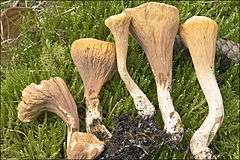Clavariadelphus truncatus
Clavariadelphus truncatus is a species of mushroom. The common name of the species is club coral. It is a member of the basidiomycete fungi family Gomphaceae.
| Clavariadelphus truncatus | |
|---|---|
 | |
| Scientific classification | |
| Kingdom: | |
| Division: | |
| Class: | |
| Subclass: | |
| Order: | |
| Family: | |
| Genus: | |
| Species: | C. truncatus |
| Binomial name | |
| Clavariadelphus truncatus | |
| Synonyms | |
|
Clavariadelphus borealis V.L. Wells & Kempton | |
Description
The species has a fruiting body in the shape of a club. The flesh is white, thin, and hollow at the top.[1] The vertical side of the fruiting body normally has folds and wrinkles, but can be smooth. The spores are smooth and their spore print is pale yellow to ochre.[2] The yellow chanterelle is distantly related to the mushroom and looks nearly the same, except for the ridges and cross-veined hymenium.[3] The authors of Edible Wild Mushrooms of North America said that they think that it is unlikely that anyone would confuse the mushroom with another species.[4]
Habitat
The mushroom's habitat is in coniferous forests from summer to autumn.[1] The mushroom is a common species.[5] The species is found at a high elevation and is widely distributed.[6] C. truncatus can bioaccumulate significant amounts of zinc,[7] and radioactive caesium-137.[8]
Edibility
The mushroom is edible and has a sweet taste.[1] While the species is edible, old mushrooms may be spongy and soft inside.[9] The species is high in nutrition and can be used for cooking.[10] The authors of North American mushrooms: a field guide to edible and inedible fungi said that the mushroom has a pleasant odor.[1] A Field Guide to Mushrooms: North America says that the mushroom is one of the best to eat and has a sweet flavor that is especially appealing to some people.[11] David Arora, the author of Mushrooms demystified: a comprehensive guide to the fleshy fungi, said that the mushroom can be sauteed and served for dessert.[12]
Medicinal
The mushroom contains clavaric acid, which has been shown to reduce the rate of tumor development when given to mice.[13] Clavaric acid interferes with farnesyltransferase, an enzyme implicated in tumorigenesis, which suggests that clavaric acid may have therapeutic value in the treatment of certain cancers.[13]
See also
Medicinal mushrooms
References
- K. Miller, Orson; Miller, Hope (2006). North American mushrooms: a field guide to edible and inedible fungi. Globe Pequot. p. 343. ISBN 978-0-7627-3109-1.
- C. Roody, William (2003). Mushrooms of West Virginia and the Central Appalachians. Kentucky: University Press of Kentucky. p. 408. ISBN 978-0-8131-9039-6.
- "Clavariadelphus truncatus". California Fungi. Retrieved 2010-01-17.
- Authors, Multiple (1992). Edible Wild Mushrooms of North America: A Field-To-Kitchen Guide. Texas: University of Texas Press. p. 114. ISBN 978-0-292-72080-0.
- "Clavariadelphus truncatus". University of Guelph. Retrieved 2010-01-17.
- Stucky Evenson, Vera (1997). Mushrooms of Colorado and the Southern Rocky Mountains. Big Earth Publishing. p. 165. ISBN 978-1-56579-192-3.
- Gonen, TF; Yamac M, Cabuk A, Yildiz Z, M; Cabuk, A; Yildiz, Z (2008). "Selection of newly isolated mushroom strains for tolerance and biosorption of zinc in vitro". Journal of Microbiology and Biotechnology. 18 (3): 483–489. PMID 18388466.CS1 maint: multiple names: authors list (link)
- Gaso, MI; Segovia N, Morton O, Lopez JL, Machuca A, Hernandez E, N; Morton, O; Lopez, JL; Machuca, A; Hernandez, E (2007). "Radioactive and stable metal bioaccumulation, crystalline compound and siderophore detection in Clavariadelphus truncatus". Journal of Environmental Radioactivity. 97 (1): 57–69. doi:10.1016/j.jenvrad.2007.03.003. PMID 17466420.CS1 maint: multiple names: authors list (link)
- Smith, Alexander Hanchett; Weber, Nancy S. (1980). The mushroom hunter's field guide. Michigan: University of Michigan Press. p. 79. ISBN 978-0-472-85610-7.
- Persson, Olle (1998). The chanterelle book. Ten Speed Press. p. 78. ISBN 978-0-89815-947-9.
- Authors, Multiple (1998). A Field Guide to Mushrooms: North America. Houghton Mifflin Harcourt. p. 72. ISBN 978-0-395-91090-0.
- Arora, David (1986). Mushrooms demystified: a comprehensive guide to the fleshy fungi. Ten Speed Press. pp. 634. ISBN 978-0-89815-169-5.
Clavariadelphus truncatus.
- Jayasuriya, Hiranthi; Silverman, Keith C.; Zink, Deborah L.; Jenkins, Rosalind G.; Sanchez, Manuel; Pelaez, Fernando; Vilella, Dolores; Lingham, Russell B.; Singh, Sheo B. (1998). "Note Clavaric Acid: A Triterpenoid Inhibitor of Farnesyl-Protein Transferase from Clavariadelphus truncatus". Journal of Natural Products. 61 (12): 1568–1570. doi:10.1021/np980200c. PMID 9868169.
External links
- Healing-mushrooms.net Image & description of bioactive properties